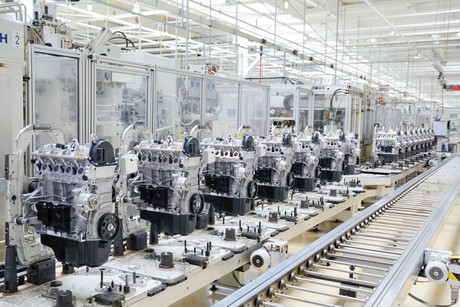I4.0: How do we create smart factories?

Over the years, global manufacturing industries have been propelled by four disruptions: the usage of mechanisation as well as water and steam powered machines during the 18th century (Industry 1.0). The mass production based on the division of labour and powered by electrical energy (Industry 2.0), the adoption of electronics (PLC controllers) and IT for further automation of executing processes (Industry 3.0). Now we see the emergence of cyber-physical systems, the Internet of Things, cloud computing and cognitive computing (Industry 4.0).
Industry 4.0 is the full digitisation of production and logistics — right down to machines that control themselves and optimise their own work steps. Intelligent sensors are a crucial element of this vision. This is why we are already laying the foundations for dynamic and real-time optimised processes for the future. As providers of data to enable 4.0, sensors are an essential technology in smart factories. As sensor experts, we understand the responsibility we bear: our products, systems and services are consistently designed for reliability, including in virtual networks. We enable our customers to collect targeted, application-specific data by individually configuring our sensors for optimised and efficient production processes. The seamless networking of individual production steps means that you can combine these steps in any way you require, with full traceability. You can create tailored products on request, and all production steps become fully traceable in real time — efficiency, flexibility and transparency are the hallmarks of the smart factory.
Within Australia, we face many challenges in the manufacturing sector, and these challenges continue as we compete in the global arena. In today’s market, consumers demand high-quality products, individualisation, seamless customer experience and on-time delivery. To be able to capture that market requirement we need to develop the backend infrastructure to produce and deliver our products in real time within a similar price range to the traditional mass produced product. Taking on the I4.0 methodologies is the first step towards offering that competitive advantage now and in the future.
One of the biggest challenges is how we transition towards Industry 4.0. The answer is not that simple; it is rather a journey typically commencing with a digital strategy: what do we want to achieve from digitalisation? And at the same time, we see many organisations struggling to understand their complete supply chain from resource extraction all the way to point of sale. I met an organisation last year that had commenced the digital journey, and the biggest eye-opener for them was not understanding their complete supply chain. So they went back to basics, used flip charts and documented every step throughout their supply chain; they then applied lean thinking principles, and only after that did they go digital. The theory was that if you apply digitalisation to a broken thing you will have a digitalised broken thing.
The point is that if we Australians can channel our ingenuity and creativity towards Industry 4.0, the pay-offs will be impressive. The industry is overloaded as we undergo rapid and transformational technological change and so to capture the projected impact (I4.0) of $10 trillion globally on GDP, it is imperative that we take action and not operate in isolation. We need to recognise the value of our scientists, researchers and out-of-the-box thinkers who are leading disruption of traditional business models with their work.
Researchers developing automated electronics disassembly
Over 80% of e-waste ends up in landfill or incinerators, including all the valuable raw...
Coming in May: Australian Manufacturing Week 2025
Registration is now open for the biggest precision engineering manufacturing show ever held in...
2025 Thought Leaders: Martin Broglia
Martin Broglia of Bonfiglioli Australia and New Zealand discusses the business of sustainability...








